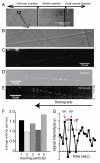A novel method for producing mono-biotinylated, biologically active neurotrophic factors: an essential reagent for single molecule study of axonal transport
- PMID: 21756937
- PMCID: PMC3158612
- DOI: 10.1016/j.jneumeth.2011.06.020
A novel method for producing mono-biotinylated, biologically active neurotrophic factors: an essential reagent for single molecule study of axonal transport
Abstract
In this report, we describe a novel method for producing mature and biologically active mono-biotinylated nerve growth factors (mBtNGF) that can be used for single molecule studies of real-time movement of neurotrophins within axons of neurons. We inserted an AviTag sequence into the C-terminal of the full length mouse preproNGF cDNA and cloned the fusion construct into a pcDNA3.1 mammalian expression vector. We also subcloned the Escherichia coli biotin ligase, BirA, into a pcDNA3.1 vector. These two plasmids were then transiently co-expressed in HEK293FT cells. As a result, the AviTag located in the C-terminal of preproNGF was selectively ligated to a single biotin by BirA. The prepro sequence of NGF was subsequently cleaved within the cell. Mature mono-biotinylated NGF (mBtNGF) was secreted into cell culture media and was purified using Ni resin. We carried out activity assays and our results showed that mBtNGF retained biological activities that were comparable to normal NGF purified from mouse sub maxillary glands. We further verified the biotinylation efficiency of mBtNGF and the level of non-biotinylated NGF was virtually undetectable in the final preparation. Finally, by conjugating to quantum-dot streptavidin, mBtNGF was successfully used for single molecule study of axonal NGF trafficking in neurons.
Copyright © 2011 Elsevier B.V. All rights reserved.
Figures




Similar articles
-
In vivo biotinylation of the major histocompatibility complex (MHC) class II/peptide complex by coexpression of BirA enzyme for the generation of MHC class II/tetramers.Hum Immunol. 2004 Jul;65(7):692-9. doi: 10.1016/j.humimm.2004.04.001. Hum Immunol. 2004. PMID: 15301857
-
Detection of protein-protein interactions using nonimmune IgG and BirA-mediated biotinylation.Biotechniques. 2010 Dec;49(6):881-6. doi: 10.2144/000113550. Biotechniques. 2010. PMID: 21143209 Free PMC article.
-
Metabolic biotinylation of recombinant antibody by biotin ligase retained in the endoplasmic reticulum.Biomol Eng. 2007 Sep;24(3):283-91. doi: 10.1016/j.bioeng.2007.02.003. Epub 2007 Feb 15. Biomol Eng. 2007. PMID: 17379573 Free PMC article.
-
A one-process production of completely biotinylated proteins in a T7 expression system.Biotechnol Appl Biochem. 2024 Oct;71(5):1070-1078. doi: 10.1002/bab.2598. Epub 2024 May 21. Biotechnol Appl Biochem. 2024. PMID: 38770738
-
In vivo enzymatic protein biotinylation.Biomol Eng. 1999 Dec 31;16(1-4):119-25. doi: 10.1016/s1050-3862(99)00046-7. Biomol Eng. 1999. PMID: 10796994 Review.
Cited by
-
An Optimized Procedure for the Site-Directed Labeling of NGF and proNGF for Imaging Purposes.Front Mol Biosci. 2017 Feb 2;4:4. doi: 10.3389/fmolb.2017.00004. eCollection 2017. Front Mol Biosci. 2017. PMID: 28210618 Free PMC article.
-
Aberrant GlyRS-HDAC6 interaction linked to axonal transport deficits in Charcot-Marie-Tooth neuropathy.Nat Commun. 2018 Mar 8;9(1):1007. doi: 10.1038/s41467-018-03461-z. Nat Commun. 2018. PMID: 29520015 Free PMC article.
-
Deconstruction of the beaten Path-Sidestep interaction network provides insights into neuromuscular system development.Elife. 2017 Aug 15;6:e28111. doi: 10.7554/eLife.28111. Elife. 2017. PMID: 28829740 Free PMC article.
-
Quantum dot targeting with lipoic acid ligase and HaloTag for single-molecule imaging on living cells.ACS Nano. 2012 Dec 21;6(12):11080-7. doi: 10.1021/nn304793z. Epub 2012 Dec 5. ACS Nano. 2012. PMID: 23181687 Free PMC article.
-
Real-time imaging of axonal transport of quantum dot-labeled BDNF in primary neurons.J Vis Exp. 2014 Sep 15;(91):51899. doi: 10.3791/51899. J Vis Exp. 2014. PMID: 25286194 Free PMC article.
References
Publication types
MeSH terms
Substances
Grants and funding
LinkOut - more resources
Full Text Sources
Research Materials

